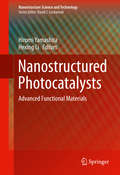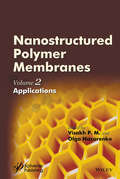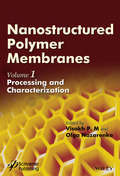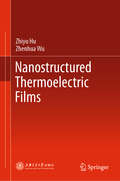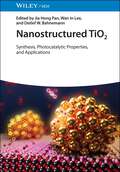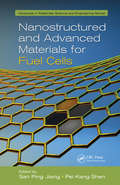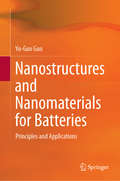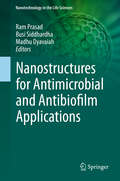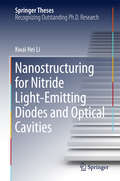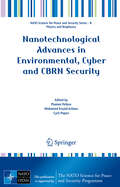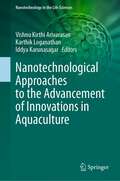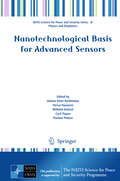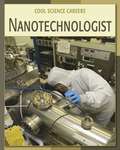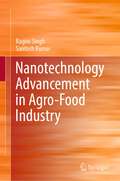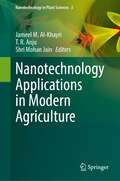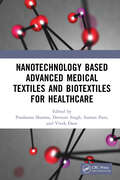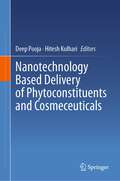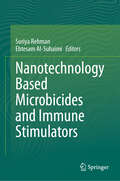- Table View
- List View
Nanostructured Photocatalysts
by Hiromi Yamashita Hexing LiWhile books on semiconductor TiO2 photocatalysis are legion, nanostructured controlled photocatalysts are attractive beyond standard semiconductors, and this book is devoted to the many novel uses of advanced TiO2 and MOF-based photocatalysts. Details on synthesis, characterization, and reaction applications of nanostructured photocatalysts are summarized. Other new materials discussed in this book are Bi- W- oxides, metal complexes, and unique porous materials. This book contains methods of preparation and characterization of unique nanostructured photocatalysts, and details about their catalytic action. Contributors to this volume are leading Asian researchers in Photocatalysis. It will appeal to researchers wishing to know how to design new types of photocatalysts with controlled nanostructures.
Nanostructured Polymer Membranes: Applications
by Visakh P. M. Olga NazarenkoThe 2nd volume on applications with discuss the various aspects of state-of-the-art, new challenges and opportunities for gas and vapor separation of polymer membranes, membranes for wastewater treatment, polymer electrolyte membranes and methanol fuel cells, polymer membranes for water desalination, optical, electrochemical and anion/polyanion sensors, polymeric pervaporation membranes, organic-organic separation, biopolymer electrolytes for energy devices, carbon nanoparticles for pervaporation polymeric membranes, and mixed matrix membranes for nanofiltration application.
Nanostructured Polymer Membranes: Processing and Characterization
by Visakh P. M. Olga NazarenkoThis book is intended to serve as a “one-stop” reference resource for important research accomplishments in the area of nanostructured polymer membranes and their processing and characterizations. It will be a very valuable reference source for university and college faculties, professionals, post-doctoral research fellows, senior graduate students, and researchers from R&D laboratories working in the area of polymer nanobased membranes.
Nanostructured Surfaces, Nanocomposites and Nanomaterials, and Their Applications: Selected Proceedings of the 10th International Conference on Nanotechnologies and Nanomaterials (NANO2022), 25—27 August 2022, Ukraine (Springer Proceedings in Physics #296)
by Leonid Yatsenko Olena FesenkoThis book highlights some of the latest advances in nanotechnology and nanomaterials from leading researchers in Ukraine, Europe and beyond. It features contributions presented at the 10th International Science and Practice Conference Nanotechnology and Nanomaterials (NANO2022), which was held in hybrid format on August 25-27, 2022 at Lviv House of Scientists, and was jointly organized by the Institute of Physics of the National Academy of Sciences of Ukraine, University of Tartu (Estonia), University of Turin (Italy), and Pierre and Marie Curie University (France). Internationally recognized experts from a wide range of universities and research institutions share their knowledge and key findings on material properties, behavior, synthesis and their applications.The book will be interesting for leading scientists, advanced undergraduate and graduate students in material and nanoscience. This book’s companion volume also addresses topics such as nano-optics, nanoelectronics, energy storage, nanochemistryl and biomedical applications.
Nanostructured Thermoelectric Films
by Zhiyu Hu Zhenhua WuThis book presents a range of low-dimensional superlattice thermoelectric materials based on physical vapor deposition (PVD) methods and explores various material types, thicknesses, and processing conditions. With the advances made in the performance of semiconductor thermoelectric materials and the efficiency of thermoelectric devices in recent years, thermoelectric power generation systems are likely to replace traditional mechanical heat engines, offering an environmentally friendlier alternative. The use of low-dimensional, nanostructured materials can significantly increase the density of states near the Fermi level and greatly improve the thermoelectric properties of materials. In addition, the book demonstrates that it is possible to influence thermoelectric performance, establish more accurate mathematical models through the regulation of relevant parameters, and ultimately improve the thermoelectric figure of merit (ZT).
Nanostructured TiO2: Synthesis, Photocatalytic Properties, and Applications
by Detlef W. Bahnemann Wan In Lee Jiahong PanComprehensive reference on TiO2 materials, from fundamentals to widely used areas such as water purification and solar fuel generation With in-depth analysis and coverage, Nanostructured TiO2 is an advanced reference on the subject, offering techniques, characterizations, and novel approaches to titanium dioxide (TiO2) nanostructures. The book incorporates cutting-edge research findings and innovations in the synthesis and utilization of TiO2 nanostructures. From environmental remediation and renewable energy to biomedical applications and advanced materials science, this book provides insights into how these materials are transforming a wide range of industries. In addition to theory and research, the book provides practical insights including real-world case studies, experimental protocols, and problem-solving techniques. Nanostructured TiO2 includes information on: Controllable synthesis of zero- to three-dimensional TiO2 nanostructures, immobilization of TiO2 on various substrates, and surface modification of TiO2 Photocatalytic fixed-bed reactions for efficient photon utilization of TiO2 and carrier transport and recombination in sensitized nanostructured TiO2 Type, characterization, and activity of TiO2-based heterojunction photocatalysts Application of TiO2 for the photocatalytic conversion of nitrogen oxides NO and NO2 Recycling of heavy metal ions from wastewater by TiO2 photocatalysis Nanostructured TiO2 is an essential up-to-date reference for inorganic chemists, catalytic chemists, materials scientists, photochemists, and professionals in the sensor industry seeking state-of-the-art knowledge on the subject.
Nanostructured and Advanced Materials for Fuel Cells (Advances in Materials Science and Engineering)
by San Ping Jiang Pei Kang ShenBoasting chapters written by leading international experts, Nanostructured and Advanced Materials for Fuel Cells provides an overview of the progress that has been made so far in the material and catalyst development for fuel cells. The book covers the most recent developments detailing all aspects of synthesis, characterization, and performance.It
Nanostructures and Nanoconstructions based on DNA
by Yuri M. Yevdokimov V.I. Salyanov S.G. SkuridinEvolutionally optimized biomolecules and their complexes present attractive objects in the production of functionalized nanoobjects. Indeed, nucleic acid-based molecules are primary candidates as building blocks for development of nanoscale systems and devices.Written for chemists, physicists, molecular biologists, and students in related fields, N
Nanostructures and Nanomaterials for Batteries: Principles and Applications
by Yu-Guo GuoThis book discusses the roles of nanostructures and nanomaterials in the development of battery materials for state-of-the-art electrochemical energy storage systems, and provides detailed insights into the fundamentals of why batteries need nanostructures and nanomaterials. It explores the advantages offered by nanostructure electrode materials, the challenges of using nanostructured materials in batteries, as well as the rational design of nanostructures and nanomaterials to achieve optimal battery performance. Further, it closely examines the latest advances in the application of nanostructures and nanomaterials for future rechargeable batteries, including high-energy and high-power lithium ion batteries, lithium metal batteries (Li-O2, Li-S, Li-Se, etc.), all-solid-state batteries, and other metal batteries (Na, Mg, Al, etc.). It is a valuable reference resource for readers interested in or involved in research on energy storage, energy materials, electrochemistry and nanotechnology.
Nanostructures for Antimicrobial and Antibiofilm Applications (Nanotechnology in the Life Sciences)
by Ram Prasad Busi Siddhardha Madhu DyavaiahIn the pursuit of technological advancement in the field of biotechnology and pharmaceutical industries to counteract health issues, bacterial infections remain a major cause of morbidity and mortality. The ability of bacterial pathogens to form biofilms further agglomerates the situation by showing resistance to conventional antibiotics. To overcome this serious issue, bioactive metabolites and other natural products were exploited to combat bacterial infections and biofilm-related health consequences. Natural products exhibited promising results in vitro, however; their efficacy in in vivo conditions remain obscured due to their low-solubility, bioavailability, and biocompatibility issues. In this scenario, nanotechnological interventions provide a multifaceted platform for targeted delivery of bioactive compounds by slow and sustained release of drug-like compounds. The unique physico-chemical properties, biocompatibility and eco-friendly nature of bioinspired nanostructures has revolutionized the field of biology to eradicate microbial infections and biofilm-related complications. The green-nanotechnology based metal and metal oxide nanoparticles and polymeric nanoparticles have been regularly employed for antimicrobial and antibiofilm applications without causing damage to host tissues. The implications of these nanoparticles toward achieving sustainability in agriculture by providing systemic resistance against a variety of phytopathogens therefore plays crucial role in growth and crop productivity. Also the advent of smart and hybrid nanomaterials such as metal-based polymer nanocomposites, lipid-based nanomaterials and liposomes have the inherent potential to eradicate bacterial biofilm-related infections in an efficient manner. The recent development of carbon-based nanomaterials such as carbon nanotubes (CNTs) and silica based nanomaterials such as mesoporous silica nanoparticles (MSNs) also exploit a target of dreadful healthcare conditions such as cancer, immunomodulatory diseases, and microbial infections, as well as biofilm-related issues owing to their stability profile, biocompatibility, and unique physio-chemical properties. Recently novel physical approaches such as photothermal therapy (PTT) and antimicrobial photodynamic therapy (aPDT) also revolutionized conventional strategies and are engaged in eradicating microbial biofilm-related infections and related health consequences. These promising advancements in the development of novel strategies to treat microbial infections and biofilm-related multidrug resistance (MDR) phenomenon may provide new avenues and aid to conventional antimicrobial therapeutics.
Nanostructuring for Nitride Light-Emitting Diodes and Optical Cavities
by Kwai Hei LiThis book describes the design and fabrication of novel nanostructures in III-nitride material systems. It introduces an inexpensive and ultra-efficient nanopatterning method - nanosphere lithography (NSL) - used to develop diversely functional nanostructures, including clover-shaped photonic crystals, nanorings, and nanolenses. Furthermore, the research findings previously distributed in various international scientific journals and conference papers are brought together and methodically presented in a unified form. The book is of interest to postgraduate students, university researchers, R&D engineers and scientists in the fields of nanoelectronics, optoelectronics and photonics.
Nanotechnological Advances in Environmental, Cyber and CBRN Security (NATO Science for Peace and Security Series B: Physics and Biophysics)
by Cyril Popov Plamen Petkov Mohamed Essaid AchourThis book is based on the lectures and contributions from the NATO Advanced Study Institute on 'Nanotechnological Advances in Environmental, Cyber, and CBRN Security,' held in Sozopol, Bulgaria, in September 2024. It provides a comprehensive overview of the field, incorporating articles that address the preparation and characterization of various nanoscale materials, including metals, oxides, glasses, polymers, and carbon-based materials. Additionally, the book includes contributions on the applications of these materials in diverse security and safety-related fields. The book adopts an interdisciplinary approach, drawing on the expertise of authors from physics, chemistry, engineering, materials science, and biology. A notable feature is its representation of expert knowledge from over 15 countries, offering both comprehensive papers that provide foundational insights into specific topics and concise contributions that emphasize particular applications in various security domains.
Nanotechnological Approaches in Food Microbiology
by Sanju Bala Dhull Prince Chawla Ravinder KaushikNanotechnology has gained attention in all aspects of modern science, having vital applications in the food chain, storage, quality monitoring, processing, preservation, and packaging. The global population is increasing rapidly, therefore there is a requirement to produce food products in a more proficient, non-toxic, and sustainable way. Food scientists and microbiologists are interested in food safety and quality assurance to produce excellent-quality food free of food pathogens Nanotechnological Approaches in Food Microbiology provides a systematic introduction and comprehensive information about practical approaches and characteristic features related to the significant applications of nanotechnology in food microbiology, including, nano-starch films, nanoemulsions, biogenic nanoparticles, and nanocapsules. The book will explore details about metal nanoparticle synthesis, characterization, mathematical modeling, kinetic studies, and their antimicrobial approaches. Key Features: Includes comprehensive knowledge on metal nanoparticle synthesis, characterization, mathematical modeling, kinetic studies and their antimicrobial approaches Lays out concepts of essential oil nanoemulsion and their potential antimicrobial applications Deals with the latest development in nano-starch composite biofilms containing bioactive constituents to inhibit pathogenic microbes Explores the nanocapsules as potential antimicrobial agents in food. Provides information regarding new biogenic nano-antimicrobials developed for the food safety and quality assurance This book will educate readers on the aspects of nanotechnology in food safety and quality assurance. Nanoemulsions, nanohydrogels, metal nanoparticles, nano-starch films, nanocapsules and nano-antimicrobials are the emerging essentials of nanotechnology that are used to preserve the food at greater extent. This book should be of interest to a large and varied audience of researchers in academia, industry, food processing, preservation, packaging, microbiology and policy regulations.
Nanotechnological Approaches to the Advancement of Innovations in Aquaculture (Nanotechnology in the Life Sciences)
by Vishnu Kirthi Arivarasan Karthik Loganathan Iddya KarunasagarThe main practical breakthrough of this century is nanobiotechnology, an amalgamation of biology and nanotechnology based on the standards and methods of metabolism. The field mainly involves the analysis, synthesis and the links between molecular biology, nutritional science and nanotechnology. In addition, the field involves the links between other life sciences branches, since the improvement of nanotechnology strategies might be directed by considering the structure and the capability of nanoparticles present in the living cells. This book is a comprehensive evaluation of the latest nanobiotechnological developments, with an emphasis on applications, especially in aquaculture. It outlines, in-depth, modern techniques, and includes a variety of important sources that make this the perfect resource for researchers in this captivating world of nanobiotechnology.
Nanotechnological Basis for Advanced Sensors
by Wilhelm Kulisch Cyril Popov Johann Peter Reithmaier Perica Paunovic Plamen PetkovBringing together experts from 15 countries, this book is based on the lectures and contributions of the NATO Advanced Study Institute on "Nanotechnological Basis for Advanced Sensors" held in Sozopol, Bulgaria, 30 May - 11 June, 2010. It gives a broad overview on this topic, and includes articles on: techniques for preparation and characterization of sensor materials; different types of nanoscaled materials for sensor applications, addressing both their structure (nanoparticles, nanocomposites, nanostructured films, etc.) and chemical nature (carbon-based, oxides, glasses, etc.); and on advanced sensors that exploit nanoscience and nanotechnology. In addition, the volume represents an interdisciplinary approach with authors coming from diverse fields such as physics, chemistry, engineering, materials science and biology. A particular strength of the book is its combination of longer papers, introducing the basic knowledge on a certain topic, and brief contributions highlighting special types of sensors and sensor materials.
Nanotechnologies in Green Chemistry and Environmental Sustainability (Sustainability: Contributions through Science and Technology)
by Abdul Karim, Samsul AriffinNanotechnologies represent a fast-growing market and this unique volume highlights the current studies in applied sciences on sustainability of green science and technology. The chapters include modelling, machine learning, nanotechnology, nanofluids, nanosystems, smart materials and applications and solar and fuel cells technology. The authors cover simulation, additive manufacturing, machine learning and the autonomous system. Various aspects of green science as well as trans-disciplinary topics between fundamental science and engineering are presented.The book is suitable for all postgraduates and researchers working in this rapid growing research area. Features Presenting latest research on green materials and sustainability. Provide in depth discussion on modeling and simulation using latest techniques. Technical exposure for the readers on additive manufacturing principles. Numerous examples on nanofluids and nano technology are presented. Discusses computer modeling, superconductivity, nanotubes and related structures such as graphene.
Nanotechnologist (Cool Science Careers)
by Ann HeinrichsDid you ever wonder what it would be like to work with things so tiny you need special microscopes to see them? That is exactly what nanotechnologists do. These specialists work with the smallest units of matter to make new products and improve existing ones.
Nanotechnology
by Manoj Kumar Ram Prasad Vivek KumarThe latest developments in nanotechnology and detailed application methodologies to decontaminate water, air, soil, and foodWritten by a team of global experts, "Nanotechnology for Environmental Decontamination" summarizes the techniques to structure target-specific nanomaterial, and how to apply it to decontaminate the natural environment from microbes, heavy metals, industrial toxic chemicals, chemical warfare agents, and biowarfare agents. Recent developments in nanotechnology enable environmental decontamination through several target-specific nanomaterials, processes, and tools. This groundbreaking work covers these innovative methodologies in complete detail. It is an ideal resource for both professionals and graduate-level students whose specialty is nanotechnology which is applicable to environmental decontamination. "Nanotechnology for Environmental Decontamination" featuresA thorough overview of the most important developments in the field of decontaminationNanomaterial design methodologies for specific targets such as microbes, heavy metals, and chemical/bio agentsContributions from world-renowned leaders in nanotech decontaminationCoverage of a wide variety of diverse applicationsIn-depth details on: Progress in the control of decontamination using nanotechnology; Nanomaterials as a means of decontamination; Photocatalytic inactivation: air and water; Decontamination of heavy metals from water; Nanotechnology as a tool: Removal of a dense nonaqueous phase liquid (DNAPLs) from the ground water; The remediation of microbes and toxic industrial chemicals from the wastewater; Reactive sorbent materials or systems for air-water remediation; The critical investigation of pesticides and explosive removal from soil and ground using innovative technology; Biocatalysts: the scavengers of chemical warfare agent, insecticides, pesticides, explosives, industrial toxic chemicals and heavy metals; Sequestration of greenhouse gases; Antimicrobial coatings and nanoemulsions used in decontamination; Commercial challenges of decontamination and nanotechnology
Nanotechnology Advancement in Agro-Food Industry
by Santosh Kumar Ragini SinghThis book provides a comprehensive insight into the growth of nanotechnology in the agri-food industry. Currently, nanotechnology serves as the most promising means to resolve the issues encountered in the food sector, as it enables the production of high-quality food with exceptional characteristics such as extended shelf life, flavor, freshness, and high nutritional content. This book focuses on the applications of nanotechnology in various fields such as smart packaging, processing, and preservation of food. It also emphasizes the role of nanomaterials in strategic design of nutraceuticals and functional foods. Along with providing an overview of the innovations and application, this book also describes future perspectives, and offers insights to ensure consumer confidence in terms of safe use. In this context the application of nanomaterials as nanosensors is additional covered. The book provides readers with a deep knowledge regarding nanomaterials-based biosensors (colorimetric, electrochemical, fiber-based) for detection of pathogens in contaminated food. Factors affecting risk assessment regulations and safety concerns regarding the use of nanomaterials in food industry have also been discussed in detail. Given its scope, this book appeals to a wider readership, especially for researchers and students who work in food agronomy and nanomaterials and nanotechnology related fields.
Nanotechnology Applications in Health and Environmental Sciences (Nanotechnology in the Life Sciences)
by Feza Korkusuz Ram Prasad Necdet SaglamNanoscience and nanotechnologies are leading to a major point to our understanding of nature. Nanotechnology can be generally defined as creation and use of nano-sized systems, devices, and structures which have special functions or properties because of their small size. This volume on Nanotechnology Applications in Health and Environmental Sciences focuses on biotechnological and environmental applications of nanomaterials. It covers popular and various nanomedical topics such as oncology, genetics, and reconstructive medicine. Additionally, many chapters give leading-edge information on nano-sensor applications and usage in specific disciplines. Also, two chapters on novel subjects have been included on Lantibiotics and microbiota. This book should be useful for nanotechnologists, microbiologists, and researchers interested in nanomedicine and nano-biotechnology, as well as environmental nanotechnology.
Nanotechnology Applications in Modern Agriculture (Nanotechnology in Plant Sciences #3)
by Shri Mohan Jain Jameel M. Al-Khayri T. R. AnjuNanotechnology is redefining the future of agriculture by offering innovative solutions for enhanced crop productivity, sustainable farming, and improved soil health. Nanotechnology Applications in Modern Agriculture presents a comprehensive exploration of cutting-edge advancements in plant nutrition, disease management, crop protection, and precision agriculture. With detailed insights into nanoparticle synthesis, nanoencapsulation, and nanosensors, this book also delves into biosafety, ethical concerns, and emerging trends. A must-read for researchers, scientists, and students, this resource provides the knowledge needed to harness nanotechnology for a more resilient and efficient agricultural landscape. Authored by a distinguished team of 79 scientists from nine countries, this book comprises 22 rigorously reviewed chapters enriched with 27 tables and 63 color figures. It serves as a definitive resource for researchers, students, agronomists and professionals committed to leveraging nanotechnology for a sustainable agricultural future.
Nanotechnology Based Advanced Medical Textiles and Biotextiles for Healthcare
by Vivek Dave Prashansa Sharma Devsuni Singh Suman PantThis book provides systematic coverage of research into medical and biotextiles based on nanomaterials as applicable in healthcare. Divided into three sections, it explains manufacturing, properties, types, and recent developments in nanotechnology based medical textiles backed by case studies. It includes a wide range of different clinical applications of biotextiles for healthcare including nanotextile scaffolds, nano-based artificial organs, surgical sutures, enzymatic assisted enhanced biotextiles, tissue engineering or drug delivery system via nanofibers, and so forth.Features: Provides strong and broad overview of medical applications in the field of nano and biotextiles. Highlights different approaches, recent research, and emerging innovations. Covers designing or developing nanomaterials based antiviral surface disinfectants with self-cleaning property. Reviews different applications of nano based medical textiles such as deodorizing or pH control clothing for hygiene maintenance. Includes the real-life applications based descriptive case studies that offer a diverse range of perspectives. This book is aimed at researchers and graduate students in textile technology and engineering, and medical textiles.
Nanotechnology Based Delivery of Phytoconstituents and Cosmeceuticals
by Deep Pooja Hitesh KulhariThis book explores the role of nanotechnology in the delivery of natural phytoconstituents and cosmeceuticals. It presents polymeric nanocarriers, lipid-based nanocarriers, metal/metal oxide nanocarriers, protein nanocarriers, and dendrimers for the delivery of phytoconstituents. Further, it focuses on the usage of phytocompounds in various cosmeceutical products and nano delivery technologies used in the delivery of various cosmeceuticals. Finally, the book reviews the toxicity issues of nanoparticles in the delivery of phytoconstituents and cosmeceuticals and regulatory aspects for clinical applications of nano phytomedicines. This book is helpful for academicians and researchers working in pharmaceutical sciences, nano science, material science, plant science, and cosmetic science.
Nanotechnology Based Microbicides and Immune Stimulators
by Suriya Rehman Ebtesam Al-SuhaimiThis book reviews the use of nano-based drug delivery systems and biomaterials to enhance the immune system against infectious diseases. It focusses on the inbuilt immunoreactive properties of nanomaterials and the advancement in its engineering to modulate the immune system either via immune-stimulation or immunosuppression. The book further discusses the use of nanoparticle-based vaccines to improve vaccine efficacy, immunization strategies, and targeted delivery to achieve desired immune responses at the cellular level against infectious diseases. Perhaps, book focusses on nanoscale diagnostics that offer new approaches for sensitive health monitoring that are potable and can guide the use of nanoscale therapies. This book explores the potential of immunomodulatory nanotechnologies, focusing not only on their benefits, but also on biocompatibility, and toxicity concerns, while highlighting promising innovations in Interferon-based immune therapies and addressing key challenges in achieving safe, scalable nanotech products. The book would encompass broad topics to attract the diverse specialty of physicians, health professionals, students, faculty, and researchers of nanotechnology, nanomedicine, infectious diseases, public health, immunology, bacteriology, virology, pathology, biotechnology, toxicology, and biomedical technology.
Nanotechnology Based Strategies for Combating Antimicrobial Resistance
by Mohmmad Younus Wani Irshad Ahmad Wani Akhilesh RaiThis book provides a comprehensive overview of recent advances in nanotechnology as an alternative strategy for addressing antimicrobial resistance (AMR). Examining nanotechnology-based methods such as nanoencapsulation, drug delivery, and conjugation, the text highlights their successful application in treating microbial infections with reduced resistance and off-target toxicity. The introductory section outlines AMR and explores diverse mechanisms of microbial resistance, emphasizing the potential of nanotechnology to surmount these challenges. Subsequent chapters investigate the role of specific nanomaterials—metal nanoparticles, metal oxide nanoparticles, functionalized quantum dots, magnetic nanoparticles, bimetallic nanoparticles, nanocomposites, carbon nanomaterials, and polymer-based nanomaterials—in overcoming antimicrobial resistance. Several chapters focus on the efficacy of nanoemulsions as an antimicrobial delivery method, underscoring their inherent antimicrobial properties, capacity to enhance drug solubility, stability, bioavailability, and targeting potential at the organ and cellular levels. The concluding section provides a detailed review of liposomes, dendrimers-based nanoparticles, and micelles as drug delivery vehicles in the context of combating pathogens resistant to antimicrobials.
